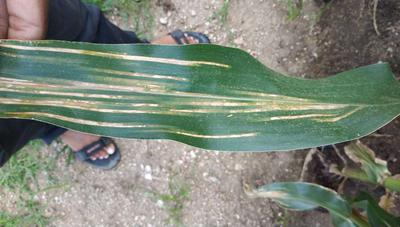Brown Stripe Downy Mildew of Maize
Sclerophthora rayssiae var. zeae
Fungus
In a Nutshell
- Occurrence of long yellow, later brownish streaks/stripes on leaves.
- Fungal growth on the lower side of leaves.
- Premature defoliation.
Can also be found in
Symptoms
Early-stage symptoms are visible as flecks or blobs on the lowermost leaves, giving them a burnt appearance. These will enlarge lengthwise and coalesce to narrow inter-veinal striping (3-7 mm) and may extend to the full leaf length. These yellow stripes will become yellowish-tan to purple and ultimately turn brown. Lesions start developing on lower leaves as narrow chlorosis or yellow stripes, 3-7mm wide with well-defined margins and are delimited by the veins. Under high moisture conditions, greyish-white downy growth will appear on the lower side of the leaves. The leaf veins are not affected thus laminar shredding is uncommon. Only under severe infection, leaves are torn apart. Premature defoliation and suppression of ear emergence are symptoms of later stages of the disease. In contrast to crazy top disease, no malformation, stunting or leaf thickening that belongs to the downy mildew symptoms occur. Seed development may be suppressed, and the plant may die if blotching occurs prior to flowering.
Recommendations

Organic Control
To this day, no biological control methods for downy mildew are known to be effective.

Chemical Control
Always consider an integrated approach with preventive measures together with biological treatments, if available. Protectant fungicides can help to prevent the contamination of your plant. Treat the seeds with Acylalanine fungicide metalaxyl, followed by foliar application up to 30 days after planting. Mefenoxam is used in the same manner as curative and protectant systemic.
What caused it?
The symptoms are caused by the fungus Sclerophthora rayssiae var. zeae and can be very destructive in areas with frequent rainfalls (100 cm annual rainfall) and warm temperatures (22-25°C). The disease requires high level of moisture in crop canopy. Dispersion is caused by wind-blown infected leaf debris, through contact, seed contamination, and rain splashes. For zoospores, the optimal development conditions are met at 18-30°C. The pathogen survives in the soil in form of these zoospores which are viable for up to 3 years.
Preventive Measures
- Choose resistant varieties or hybrids, if available.
- Before planting, bring down the moisture content to 14% by drying the seeds and store them for several months to reduce the incidence of downy mildew.
- Provide good spacing between plants.
- Control weeds in and around the field.
- Remove plant residues from the field.
- Keep tools and equipment clean.
- Avoid distribution of infected soil and plant material.
- Other hosts of S.
- rayssiae var.
- zeae are crabgrass, sorghum, and sugarcane.
- Rogue out infected plants at an early stage.



